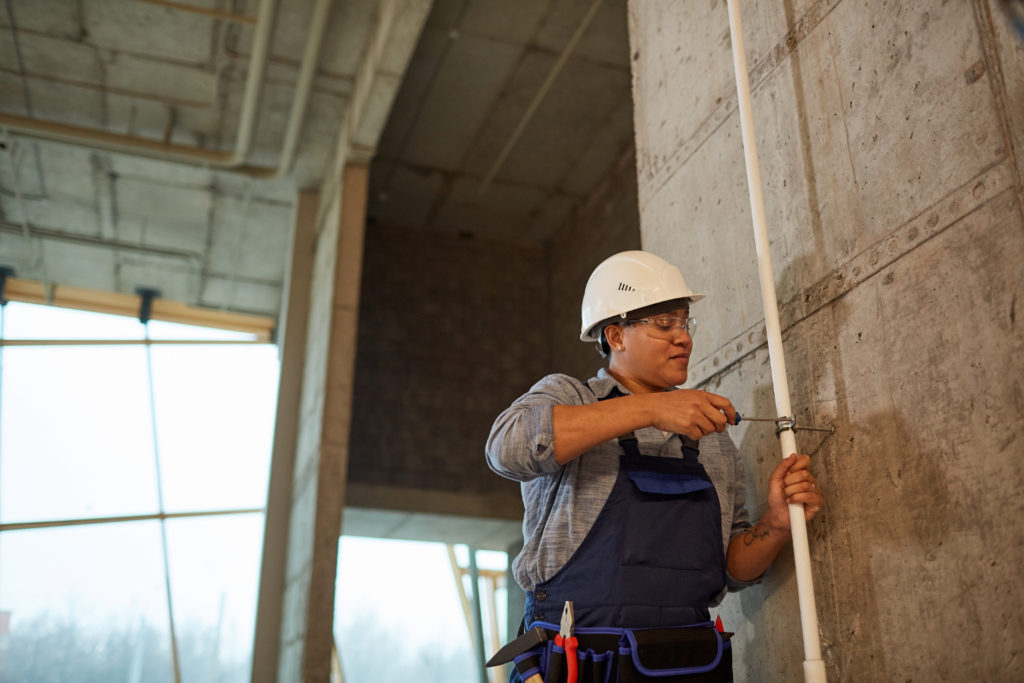Explore: Industrial & Construction Careers

Cable Installer
Cable installers work in homes, businesses, and on construction sites to install and repair telecommunications cables. This includes phone lines, internet cables, security systems, or cable television.

Commercial Driver
Commercial drivers operate large vehicles such as buses, Access-A-Ride vehicles, and trucks. Truck drivers move cargo from one location to another, while bus drivers transport people.

Construction Worker
Construction workers build everything from office buildings, roads, and schools to factories and homes. Construction could be a great employment option for people who are mechanically inclined and do not want an office job.

Cable Installer
Cable installers work in homes, businesses, and on construction sites to install and repair telecommunications cables. This includes phone lines, internet cables, security systems, or cable television.

You Are
- Looking to work with your hands
- Detail oriented
- Able to lift 70 pounds
- Able to distinguish different cable colors
- Comfortable with heights and small spaces













What You’ll Do
- Run cable behind walls and ceilings to support the critical technology and data infrastructure for offices, trading floors, and other sites
- Stand on ladders, pull cable through walls, and test and troubleshoot connectivity
- Spend most of your day out in the field, on construction sites, or in office buildings













Salary
Cable Installation Technicians in New York City earn an average of $38,853 ($19/hour). [Source: Glassdoor]













Growth Projections
Prior to COVID-19, employment for this career was projected to decline 6 percent from 2018 to 2028 [Source: U.S. Bureau of Labor Statistics], but New York was also listed as one of the top 5 states with the highest employment level in this occupation. [Source: U.S. Bureau of Labor Statistics]
While it is not yet clear how COVID-19 may have impacted these projections, it is anticipated that there will still be a steady demand for cable installers to support construction and related industries.




Commercial Driver
Commercial drivers operate large vehicles such as buses, trucks, and Access-A-Ride vehicles. Truck drivers move cargo from one location to another, while bus drivers transport people.















You Are
- Someone who enjoys driving
- A valid New York State driver’s license (Class D) holder for at least two years
- Someone with a clean driving record with NO driving under the influence (DUI) or driving while intoxicated (DWI) violations
- Someone whose driving record displays no more than one of the following:
- Four points or fewer
- One suspension (must be cleared for at least two years)
- Two convictions or fewer
- Comfortable working a flexible schedule that could include driving throughout and outside of New York City
- Willing to undergo drug testing
- Willing to take a medical exam to meet the NYS Department of Motor Vehicle’s (DMV) medical certification requirements













What You’ll Do
- Safely drive and maneuver large commercial vehicles, such as school buses, coach buses, and trucks, to transport people or products from one location to another
- Use maps to plan routes and navigate traffic
- Perform routine checks and maintenance for vehicle













Salary
Commercial driving jobs, including for school bus, coach bus, Access-a-Ride, and truck driving positions, have starting salaries ranging from $17 to $22 per hour. [Source: Red Hook on the Road program data]













Growth Projections
Prior to COVID-19, employment of bus drivers [Source: U.S. Bureau of Labor Statistics] and heavy truck drivers [Source: U.S. Bureau of Labor Statistics] was projected to grow 5% from 2018 to 2028.
It is not clear how COVID-19 will impact these projections, but we expect the demand for truck drivers to continue to meet the ongoing need for consumer goods and to keep supply chains moving. It is expected that there will be less need for school bus drivers as in-person school attendance will be limited.


Construction Worker
Construction workers build everything from office buildings, roads, and schools to factories and homes. Construction could be a great employment option for people who are mechanically inclined and do not want an office job.













You Are
- Comfortable with heights and confined spaces
- Able to work a flexible schedule that includes early mornings and weekends
- Comfortable working outdoors in all weather conditions
- Interested in seeing the tangible results of your labor
- Someone who enjoys a job with a strong physical component, which can include:
- Manual labor
- Working with your hands (e.g. using hand and power tools)
- Wearing personal protective equipment (e.g. hardhat)
- Climbing ladders
- Bending and lifting items weighing 50 lbs.













What You’ll Do
The construction sector covers a wide range of trades and within each trade, there are multiple crafts.
Review the following construction trades for more detail on what people with these jobs do, their salary, and growth projections:













Salary
The salary for construction workers varies by trade. See the trade descriptions linked above for more details.
The salary for construction workers also varies based on whether the job is a union or non-union position. A labor union, also known as a trade union or union, is an organized group of workers who join together to bargain with employers regarding conditions that impact their employment, including salary, benefits, and working conditions. [Sources: The Balance Careers and Union Plus]
Union construction jobs tend to be permanent positions and have better conditions, including pay, hours, and benefits, compared to jobs outside of a union which are typically for a set period of time. As a result, getting into a construction union can be challenging. We offer a Construction Pre-Apprenticeship program which prepares people and helps them gain access to a union apprenticeship.













Growth Projections
Prior to COVID-19, construction laborer jobs were projected to grow 4% nationally by 2029 [Source: U.S. Bureau of Labor Statistics] and grow 10% in New York City over the next 10 years. [Source: Labor Insight™ from Burning Glass]
It is not clear how COVID-19 will impact these projections, but we expect the need for construction workers to continue.






Carpenter
Carpenters build and repair building frameworks and structures made from wood and other materials. They also install kitchen cabinets, siding, and drywall. [Sources: Helmets to Hardhats and O*NET OnLine]
Salary
Carpenters in New York earn an average of $57,510 annually. [Source: O*NET OnLine]
Growth Projections
Prior to COVID-19, carpenter jobs were projected to stay the same nationally [Source: U.S. Bureau of Labor Statistics] and grow 8% in New York City over the next 10 years. [Source: Labor Insight™ from Burning Glass]
It is not clear how COVID-19 will impact these projections, but we expect the need for carpenters to continue.


Construction Laborer
Construction laborers perform many tasks that require physical labor on construction sites. Laborers work at building, highway, and heavy construction sites. [Sources: Helmets to Hardhats and O*NET OnLine]
Salary
Construction Laborers in New York earn an average of $46,580 annually. [Source: O*NET OnLine]
Growth Projections
Prior to COVID-19, construction laborer jobs were projected to grow 5% nationally by 2029 [Source: U.S. Bureau of Labor Statistics] and grow 12% in New York City over the next 10 years. [Source: Labor Insight™ from Burning Glass]
It is not clear how COVID-19 will impact these projections, but we expect the need for construction laborers to continue.


Electrician
Electricians install, maintain, and repair electrical power, communications, lighting, and control systems in homes, businesses, and factories. [Sources: Helmets to Hardhats and O*NET OnLine]
Salary
Electricians in New York earn an average of $71,640 annually. [Source: O*NET OnLine]
Growth Projections
Prior to COVID-19, electrician jobs were projected to grow 8% nationally by 2029 [Source: U.S. Bureau of Labor Statistics] and grow 13% in New York City over the next 10 years. [Source: Labor Insight™ from Burning Glass]
It is not clear how COVID-19 will impact these projections, but we expect the need for electricians to continue.


Mason
Masons use bricks, concrete blocks, or natural stones to build or repair structures that include walls, arches, and sewers. Masons smooth and finish surfaces. [Sources: The Balance Careers and O*NET OnLine]
Salary
Masons in New York earn an average of $62,080 annually. [Source: O*NET OnLine]
Growth Projections
Prior to COVID-19, mason jobs were projected to grow 13% in New York City by 2026. [Source: NYS Department of Labor]
It is not clear how COVID-19 will impact these projections, but we expect the need for masons to continue.


Painter
Painters apply paint, stain, and coatings to walls and ceilings, buildings, bridges, and other structures using brushes, rollers, and spray guns. [Sources: Helmets to Hardhats and O*NET OnLine]
Salary
Painters in New York earn an average of $47,160 annually. [Source: O*NET OnLine]
Growth Projections
Prior to COVID-19, painter jobs were not projected to stay stable nationally [Source: U.S. Bureau of Labor Statistics] but were expected to grow 8% in New York City over the next 10 years. [Source: Labor Insight™ from Burning Glass]
It is not clear how COVID-19 will impact these projections, but we expect the need for painters to continue.


Plumber
Plumbers, pipefitters, and steamfitters install and repair pipes that carry liquids or gasses for businesses, homes, and factories. [Sources: Helmets to Hardhats and O*NET OnLine]
Salary
Plumbers, pipefitters, and steamfitters in New York earn an average of $65,970 annually. [Source: O*NET OnLine]
Growth Projections
Prior to COVID-19, plumber jobs were projected to grow 5% nationally by 2029 [Source: U.S. Bureau of Labor Statistics] and grow 20% in New York City over the next 10 years. [Source: Labor Insight™ from Burning Glass]
It is not clear how COVID-19 will impact these projections, but we expect the need for plumbers to continue.


Roofer
Roofers and waterproofers replace, repair, and install the roofs and waterproofing systems using a variety of materials, including shingles, bitumen, and metal. [Sources: Helmets to Hardhats and O*NET OnLine]
Salary
Roofers in New York earn an average of $58,800 annually. [Source: O*NET OnLine]
Growth Projections
Prior to COVID-19, roofer jobs were projected to grow 2% nationally by 2029 [Source: U.S. Bureau of Labor Statistics] and grow 14% in New York City over the next 10 years. [Source: Labor Insight™ from Burning Glass]
It is not clear how COVID-19 will impact these projections, but we expect the need for roofers to continue.


Welder
Welders join metal together or fill and repair holes on metal constructions through the use of intense heat and gas, often using equipment like flame-cutting or hand-soldering. [Sources: CareerExplorer and O*NET OnLine]
Salary
Welders in New York earn an average of $44,220 annually. [Source: O*NET OnLine]
Growth Projections
Prior to COVID-19, welder jobs were projected to grow 3% nationally by 2029 [Source: U.S. Bureau of Labor Statistics] and grow 8% in New York City over the next 10 years. [Source: Labor Insight™ from Burning Glass]
It is not clear how COVID-19 will impact these projections, but we expect the need for welders to continue.